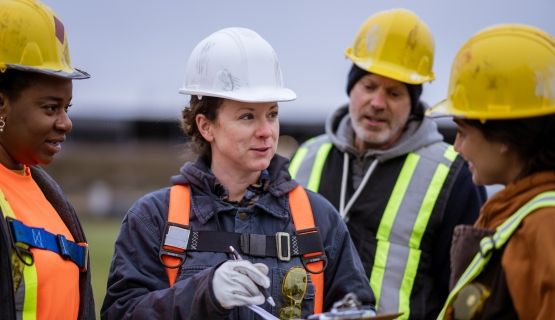Illness/injury prevention
IWH has a long history of conducting research to provide practical guidance to employers, workers, OHS professionals and regulators about what works and what doesn’t in injury or illness prevention. This research targets the injury and illness prevention practices of workplaces, as well as the programs developed by governments, health and safety associations and others to support and motivate workplaces to adopt effective practices.
Featured

At Work article
Differences in firm-level AI use for health and safety
To what extent are Canadian workplaces using artificial intelligence (AI) to help support workers’ health and safety? And what do these workplaces have in common? An IWH study surveyed firms across Ontario and British Columbia to find out.
Published: October 8, 2025

Impact case study
Saskatchewan’s construction safety group uses IWH tool to improve safety culture
This case study details how the Saskatchewan Construction Safety Association (SCSA) members have been analyzing IWH-OPM scores to adjust their safety practices and how SCSA has been using the data to tailor their outreach.
Published: February 10, 2025
Video
Video
Find the workers you need to protect
How do you tell which workers are vulnerable to injury? Occupational health and safety (OHS) vulnerability is not about who people are. It's about the work they do. Use the OHS Vulnerability Measure to identify workers you need to protect.
Published: August 2017
Video
Video
Trouvez les travailleurs à protéger
La vulnérabilité en santé et en sécurité au travail ne dépend pas de qui vous êtes. Elle dépend des fonctions que vous accomplissez. Nos recherches montrent qu’il existe une meilleure façon de repérer les travailleurs vulnérables.
Published: August 2017

IWH in the media
Weed at work
The legalization of recreational marijuana in Canada came closer to reality on April 13, when the Justin Trudeau government introduced the Cannabis Act, or Bill C-45. While pot users across the country applaud the move, others have raised concerns about the effect that the proposed legislation would have on workplace safety, writes Jeff Cottrill in an article that quotes the Institute for Work & Health's Dr. Andrea Furlan.
Published: OHS Canada, August 2017

At Work article
Therapy can help manage depression, but in Manitoba, access to therapists is a concern
Therapy can help manage depression, according to a new systematic review update. How easy is this recommendation to implement in a province like Manitoba?
Published: August 2017

Research Highlights
Workers with disabilities report greater OHS vulnerability
Workers with disabilities are more likely to be exposed to hazards at work than other workers, and are more likely to experience vulnerability due to inadequate measures to mitigate those hazards.
Published: July 2017

IWH in the media
Construction among highest spending sectors to prevent work-related injuries
The construction sector is in the top five of 17 sectors in terms of spending per worker per year on preventing work-related injury and illness, says the president and senior scientist at the Institute for Work and Health (IWH) who is conducting a pilot study on the matter
Published: Daily Commercial News, May 2017
IWH Speaker Series
IWH Speaker Series
Evaluating the impact of mandatory awareness training in Ontario
In this presentation, Dr. Peter Smith shares the results of a study that examined differences in the level of self-reported occupational health and safety (OHS) awareness and empowerment among employed workers in Ontario before and after the introduction of the mandatory OHS training. He also discusses the implications of the results for future province-wide initiatives focusing on the primary prevention of work-related injuries and illnesses.
Published: April 2017
Journal article
Journal article
The relationship between occupational health and safety vulnerability and workplace injury
Published: Safety Science, April 2017
Project report
Project report
Managing depression in the workplace: a systematic review contextualized for Manitoba
This report provides a synthesis of the relevant research-based evidence on managing depression for the adult working population of Manitoba. The synthesis is based on an international search of the literature, and the findings were then contexualized for Manitoba based on an approach developed by the Institute for Work & Health and Memorial University's SafetyNet Centre for Occupational Health and Safety Research.
Published: March 2017

Tools and guides
Evidence in context for occupational health and safety: operational handbook
This handbook, the product of a research collaboration between the Institute for Work & Health and Memorial University’s SafetyNet Centre for Occupational Health and Safety Research, can be used by occupational health, safety and disability prevention stakeholders seeking to improve policy and/or practice by contextualizing the results of a research synthesis (e.g. a systematic review) to their particular situation (e.g. particular jurisdiction, sector or workplace).
Published: March 2017